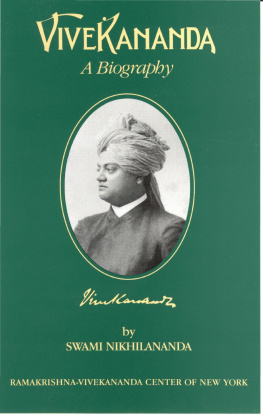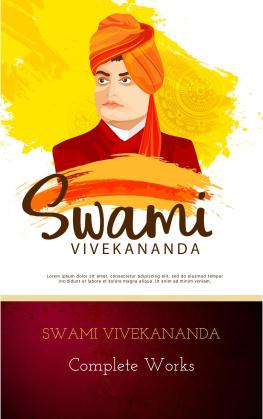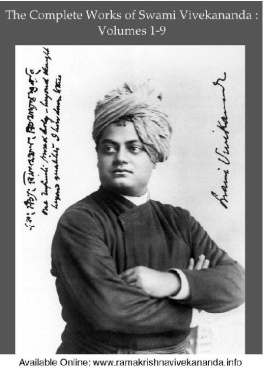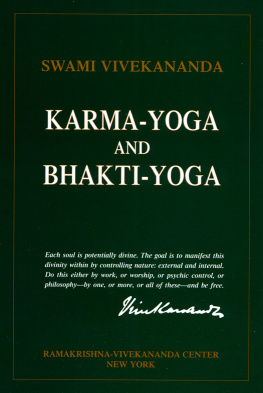Table of Contents


DEDICATION
To
My Parents
K.R. Srinivasa Iyengar (1908-1999)
&
Srimati Padmasani (1919-2007)
~
Hand in hand they stand and try to fathom depths whence springs eternal love, each in others eyes;
And find
No hold oer that age but brings the youth anew And timethe good, the pure, the true.
~ Swami Vivekananda
CONTENTS
Sthapakayacha dharmasya sarva dharma swaroopine
Avatara varishtaaya Ramakrishnaaya te namah
My maternal grandfather, M.S. Krishnaswami Iyengar, was a very orthodox Srivaishnava. A widower, he would not eat food cooked even by my mother who was his only child. He had to travel a good deal because of his work but never would he eat in a strangers house. Hotels were taboo. Wherever he stayed (even if he came to our house) he would take out his own well-packed utensils and make a simple meal of rice and dal. If he had no time or place to do his cooking, he would be content with water and fruits.
But apparently he kept his heart open. The two volume edition of The Gospel of Sri Ramakrishna which he bought in 1920 may be said to be the starting point of Sri Ramakrishna-Vivekananda literature in our house. When I contemplate upon the past, I realise that grandfathers purchase of the two volumes of the Gospel was auspicious. This was the first non-traditional piece of writing to enter the shelf of our Srivaishnava household. From that day onwards the family library has never looked back in gathering spiritual treasures of our times. As the books came in, they brought new inspirations, joys and fulfillment. Grandfather remained enclosed in orthodoxy but does it matter what he ate or how much he worried about ritual purity or why he painted a gorgeous Srivaishnava tilak on his forehead? He had the curiosity to find out what was inside the Gospel which had the subtitle: The Ideal Man for India and for the World. Later on curiosity turned to regard and respect. That makes this obscure postmaster and millions of disciplined, educated Indians of the last century like him a priceless conduit for the sustenance of our Sanatana Dharma.
That also explains the significance of Swami Vivekanandas life. More than a hundred years ago when educated young men were unable to find a meaning in their lives and remained bound to the discipline of tradition, he came as a leader to show them a royal path which would not alienate them from their tradition and yet bring them to a brave new world. Todays Indian culture is largely the work of Swami Vivekananda. I feel it is the grace of the Divine Mother that has given me this chance to write his biography. It has not been an easy task for the literature is immense and the urge to allow his words to tell the tale can be overwhelming. But it is also like wandering in the world of heroism and valour. Who wants to leave it?
Swami Nikhilanandas biography in English and Swami Ashutoshanandas in Tamil have been my mainstay throughout the planning and writing of this book. The Complete Works ofSwami Vivekananda apart, I have also drawn from the writings of Sister Nivedita, the biography of Sri Ramakrishna by Swami Saradananda, The Gospel of Sri Ramakrishna by M and other books of this area which have nurtured my writing career spanning fifty-five years.
I am grateful to Sonavi Desai for asking me to take up this work for the series on Spiritual Masters, and to Swami Satyaswarupananda for suggesting my name to her. My loving thanks to Nandakumar and my children, Ahana, Bhuvana and Raja, for making me forget my age and age-related problems. And to my personal library, a salutation in gratitude.
Prema Nandakumar
Mudhal Tirumaligai
152/91, South Chitrai Street
Srirangam 620 006
8 August 2012
Spirituality, the consciousness that is all-inclusive, is the very heart of the Indian nation. From times immemorial, this consciousness has also been nurtured with intent by the Indians. No man is considered an island. All, all is Brahman. Towards sustaining this view, Indians have successfully integrated the secular and the spiritual streams of existence. All the Vedic sacrifices were tuned towards human perfection and so have we hailed India as the Bhoga Bhumi. Self-sacrifice for the cause of Dharma has come easily to Indians whether they belonged to the Vedic-Upanishadic stream or the Sramanic pathway that has made the land a Tyaga Bhumi. The individual was never lost sight of in this move towards perfection. This has meant an assiduous cultivation of the body and the mind, by yoga. So we salute Mother India as Yoga Bhumi as well.
The Vedas are the earliest available records in our long journey towards perfection. Couched in colourful imagery, sounding somewhat obscure because of the twilight speech (sandhya bhasha) employed by the seers, but containing within them deep significances, the Vedic hymns have been the springs of Indias religion and spirituality. According to Sri Aurobindo their rhythms are carved like chariots of the gods and borne on divine and ample wings of sound. The Gayatri Mantra of Rishi Viswamitra for instance is well-known.
The Vedic Age was followed by a time of intense intellectual seeking giving us the Upanishads which form the basis of a majority of our philosophical systems and also contain some of the most heart-warming images in ones experience. They have given us immortal statements like All is Brahman and You are That. They have given us some of the most lovable stories such as that of Satyakama Jabala and Raikwa the cart-puller. They have certainly raised the flag of our Sanatana Dharma all over the world. In fact the wisdom of the East had percolated into the West even from the days of ancient Greece. During the last two centuries several Indologists have studied them deeply. Schelling, Schopenhauer, Sir Monier-Williams... the list grows long. Archibald E. Gough says,
The Upanishads are the loftiest utterances of Indian intelligence. Whatever value the reader may assign to the ideas they represent, they are the highest product of the ancient Indian mind, and almost the only elements of interest in Indian literature which is at every stage replete with them to saturation... The Upanishads have been justly characterized... as the basis of the enlightened faith of India.
Close on the heels of the Upanishadic Age, India entered the very rich and colourful heroic age with the unsurpassed epics, the Ramayana and the Mahabharata. A meeting place of the human and the divine, there is no aspect of mans everyday life and his aspirational adventures that has been left untouched by Vyasa and Valmiki. Rama is the very image of Truth and Dharma; Sita the patient, compassionate Eternal Woman. All the characters in the epic, human, divine and otherwise, exemplify various shades of good and evil in man. While the main story of the Pandava-Kaurava feud in the Mahabharata is absolutely contemporaneous as well, the numerous branch-stories like that of Savitri and Nala have also been part of the racial consciousness.
A profound stress of thought on life, a large and vital view of religion and society, a certain strain of philosophic idea runs through these poems and the whole ancient culture of India is embodied in them with a great force of intellectual conception and living presentation. The Mahabharata has been spoken of as a fifth Veda, it has been said of both these poems that they are not only great poems but dharmashastras, the body of a large religious and ethical and social and political teaching, and their effect and hold on the mind and life of the people have been so great that they have been described as the bible of the Indian people.









